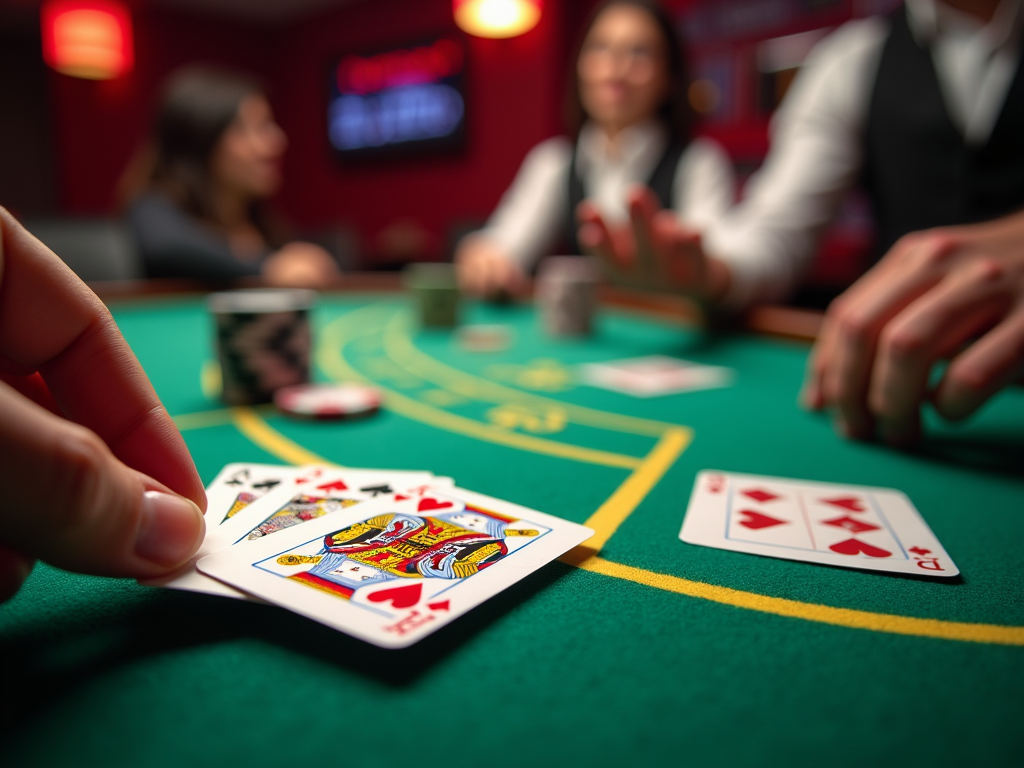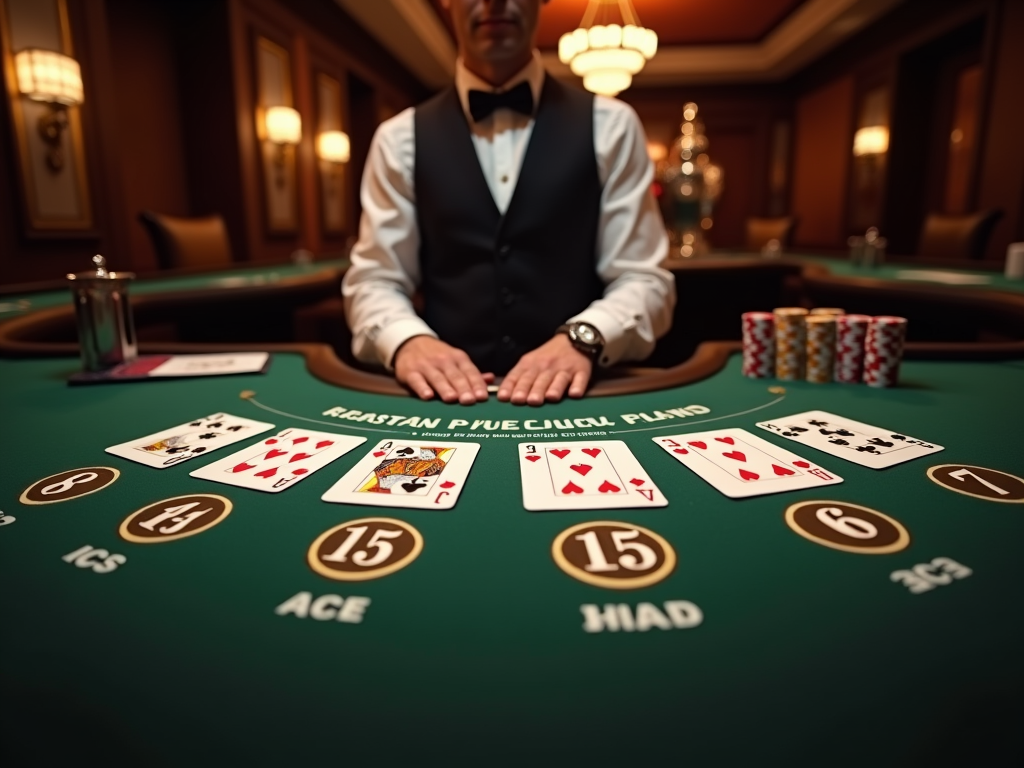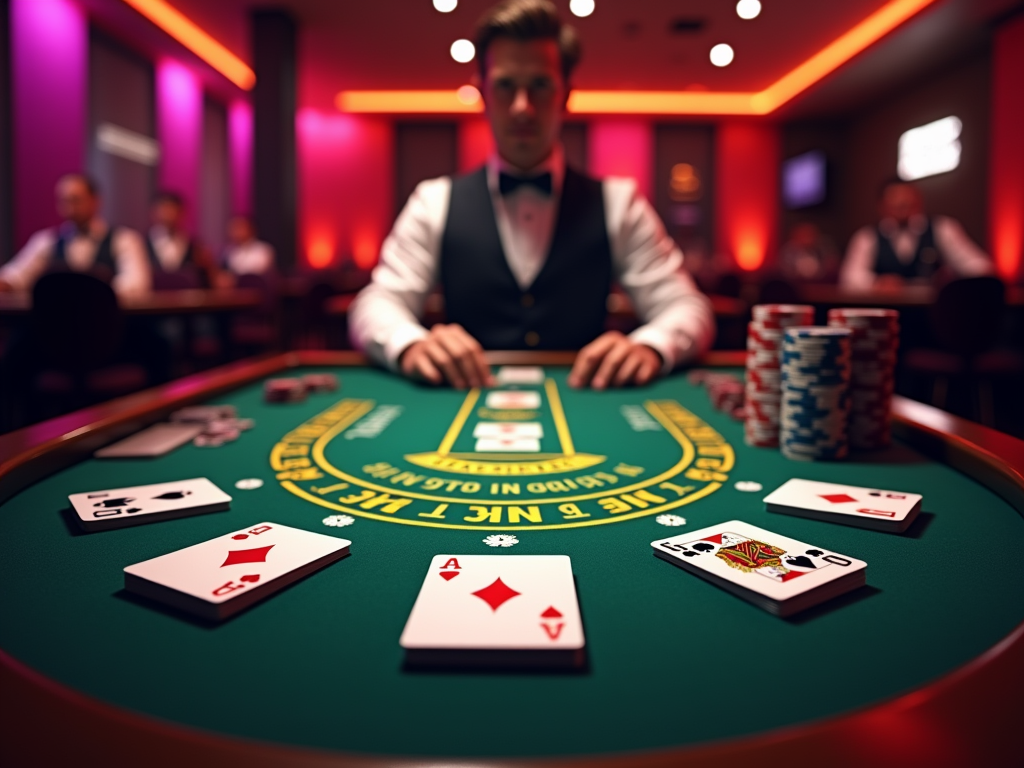Blackjack: A Skill-Driven Casino Classic
Blackjack stands as one of the most skill-driven casino card games, with players competing directly against the dealer to reach the optimal hand value of 21. The fundamental rules create a perfect balance of strategy and chance.
Key Takeaways
- Players secure victories through either a natural blackjack (Ace plus 10-value card) or by creating a hand that beats the dealer without exceeding 21.
- Card values follow straightforward rules: number cards equal their face value, face cards count as 10, and Aces adapt between 1 or 11.
- Dealers stick to fixed rules, taking additional cards at 16 or below while staying put at 17 or above.
- Basic actions include hitting for another card, standing with your current total, and doubling down by matching your initial bet for one final card.
- Regular winning hands return equal money, while natural blackjacks deliver a superior 3:2 payout, though some establishments offer reduced 6:5 returns.
Strategic Gameplay
Each hand presents unique decisions based on your cards and the dealer’s visible card. I focus on learning proper basic strategy to strengthen my odds at the table. The game rewards patient play and smart bet management while punishing reckless decisions.
Why Blackjack Appeals to Strategic Players
The mix of mathematical probability and strategic choices makes blackjack an engaging option for players seeking an advantage through skill. Success depends on consistent application of optimal play combined with disciplined betting patterns.
Win Big: The Ultimate Goal of Blackjack
The core aim of blackjack is straightforward – get a hand total closer to 21 than the dealer without going over. I’ve found that focusing on this simple objective helps players stay centered during the excitement of gameplay. When you win a standard hand, you’ll receive an even-money payout, meaning if you bet $10, you’ll win $10.
Special Payouts and Natural Blackjack
Landing a Natural Blackjack brings the biggest thrill – and profit. This premium hand consists of an Ace paired with any 10-value card (10, Jack, Queen, or King) in your first two cards. A Natural Blackjack typically pays 3:2, so a $10 bet would net you $15. However, I need to warn you about tables offering reduced 6:5 payouts on blackjacks. These tables increase the house edge by 1.4% – a significant disadvantage you’ll want to avoid.
Key Victory Conditions
Here’s what you need to know about securing wins in blackjack:
- Beat the dealer’s hand total while staying under 21
- Get dealt a Natural Blackjack (automatic win unless dealer also has blackjack)
- Keep your hand under 21 when the dealer busts
- Have a higher final hand total than the dealer
Remember, you’re only playing against the dealer, not other players at the table. It’s a common misconception that you need to beat everyone – your sole focus should be outdrawing the dealer’s hand. Going over 21 at any point results in an automatic loss, regardless of what the dealer does afterward. I’ve learned that mastering basic casino strategy and understanding betting systems can help maximize your winning potential while minimizing losses.

Master the Cards: Understanding Point Values
Basic Card Values
Getting started with blackjack means learning the point values of each card in the deck. I’ve found that card counting and value systems are straightforward once you break them down into simple categories:
- Number cards (2-10): Worth their face value
- Face cards (King, Queen, Jack): Each worth 10 points
- Ace: Special card worth either 1 or 11 points
Understanding Hand Combinations
The real skill in blackjack comes from quickly calculating different card combinations. Let’s look at some common scenarios you’ll encounter at the table. A hand with a Queen and 6 adds up to 16 points, while holding a 4 and 9 gives you 13 points.
The Ace brings an extra layer of strategy to your betting decisions and gameplay. Your hand can be either “soft” or “hard” depending on how the Ace is counted:
- Soft hands occur when counting the Ace as 11 won’t bust your hand. For example, an Ace and 5 creates a soft 16, giving you flexibility to hit without busting since the Ace can switch to 1 if needed.
- Hard hands happen in two situations: when you must count the Ace as 1 to avoid busting, or when your hand contains no Ace. Take a hand with Ace, 5, and 7 – here, counting the Ace as 11 would bust (23), so it must be counted as 1 for a total of 13.
I recommend practicing these calculations away from the table first. Start with simple two-card combinations and gradually work your way up to more complex hands involving Aces. This foundation will help you make quick, confident decisions during actual gameplay.

Your Turn: Making the Right Moves
Essential Playing Actions
Let’s break down the core moves you’ll need to master at the blackjack table. Each decision shapes your game strategy and impacts your chances of winning.
The most basic move is hitting – simply tap the table to request another card from the dealer. I recommend this action when your hand total is low and you need to improve your chances of getting closer to 21.
Standing keeps your current hand as-is, and it’s perfect when you’ve got a strong total that doesn’t need improvement. To signal a stand, wave your hand horizontally over your cards.
Double down is a power move that can really boost your profits. You’ll double your original bet and receive exactly one more card. This works best with hand totals of 10 or 11, where that single extra card has a good chance of creating a winning hand.
Advanced Playing Options
Splitting pairs creates two separate hands from matching cards, requiring you to match your original bet on the new hand. While you can split any matching cards, there’s a catch with Aces – you’ll typically only get one additional card per split Ace, and hitting afterwards isn’t allowed in most casinos.
Surrender offers a strategic retreat when the odds aren’t in your favor. By giving up half your original bet, you can bow out of a tough hand. There are two types:
- Early surrender: You can forfeit your hand before the dealer checks for blackjack
- Late surrender: You must wait until after the dealer checks for blackjack
Consider these key moments to use surrender:
- When holding a hard 16 against a dealer’s 9, 10, or Ace
- With a hard 15 against a dealer’s 10
- During unfavorable situations where the probability of winning is less than 25%
The art of blackjack comes from knowing exactly when to use each of these moves. I’d say making the right decision becomes second nature with practice, but you’ll need to stay sharp and adapt your strategy based on the specific situation at hand.
Remember, these playing options vary slightly between casinos and game variants – it’s smart to verify the specific rules before starting play. Understanding and correctly implementing these moves forms the foundation of a solid gaming strategy that can help improve your results at the table.
The Dealer’s Rules: Understanding Your Opponent
Unlike players who can make strategic choices, dealers follow strict predetermined rules that control their every move at the blackjack table. I’ve found that understanding these dealer constraints is crucial for making smart decisions during gameplay.
Standard Dealer Protocols
The dealer’s actions are completely automatic – they must hit (take another card) on any hand totaling 16 or below, and stand (take no more cards) on any hand of 17 or above. These fixed rules remove any element of dealer discretion, making their actions predictable and consistent across hands.
Hard 17 vs Soft 17 Rules
A key rule variation you’ll encounter is how dealers handle a soft 17 – a hand containing an Ace counted as 11. Some casinos require dealers to hit on soft 17 (H17 rules), while others mandate standing on soft 17 (S17 rules). According to statistics from major casino analytics firms, H17 rules increase the house edge by 0.22% compared to S17. I recommend checking which rule is in play before sitting at any table, as it impacts optimal betting strategy and gameplay decisions.
Reading the Dealer’s Upcard
The dealer’s upcard – the single card shown face-up – provides critical information for player decision-making. Here’s how I analyze the dealer’s upcard to guide my choices:
- Strong dealer upcards (7 through Ace) suggest playing more cautiously and hitting on lower totals
- Weak dealer upcards (2 through 6) often allow for more conservative play and standing on lower totals
- A dealer Ace upcard creates the highest risk for players, with a 31% chance of the dealer making blackjack
I’ve learned that mastering basic game rules and strategies is essential before advancing to more complex plays. By understanding how dealer rules constrain their actions, you can make better-informed decisions about when to hit, stand, double down, or split pairs.
Money Matters: Payouts and Outcomes
Standard Win Scenarios
I’ll break down the different ways you can win at blackjack and what to expect for payouts. In a regular winning hand, where your cards beat the dealer’s total or the dealer busts, you’ll receive a 1:1 payout. This means if you bet $10, you’ll win $10 – simple as that!
Getting a natural blackjack is where the real excitement kicks in. This happens when your first two cards are an Ace plus any 10-value card (10, Jack, Queen, or King). The standard payout for this sweet hand is 3:2, so a $10 bet would net you $15. However, I’ve noticed more casinos switching to 6:5 payouts on blackjack, which significantly cuts into potential profits – on that same $10 bet, you’d only win $12 instead of $15.
Other Common Outcomes
Here are the key scenarios you’ll encounter at the blackjack table:
- Push: When your hand ties with the dealer’s, you’ll get your original bet back
- Double Down wins: Still pay 1:1, but on your doubled bet amount
- Multiple deck games: Most casinos use 4-8 decks in their standard casino card games
- Dealer wins: You lose your bet if they beat your hand or if you bust, even if the dealer later busts too
I always remind players that understanding these payouts is crucial for managing your bankroll effectively. The shift from 3:2 to 6:5 blackjack payouts might seem small, but it increases the house edge by about 1.39%, making a significant difference over time. That’s why I suggest seeking out tables that offer the traditional 3:2 payout for optimal betting strategy implementation.
Multiple decks are standard in modern blackjack games, with 6-deck and 8-deck shoes being most common. This setup helps prevent card counting and ensures smoother gameplay, though it slightly increases the house edge compared to single-deck games.
Sources:
wizardofodds.com
pagat.com
Bicycle Cards official website
Blackbelt in Blackjack by Arnold Snyder
Professional Blackjack by Stanford Wong





